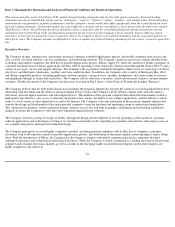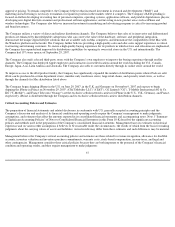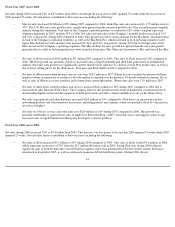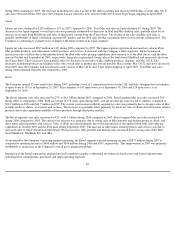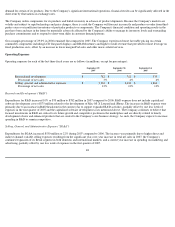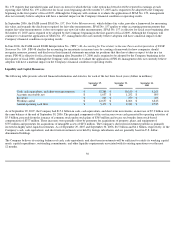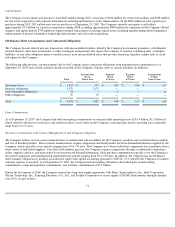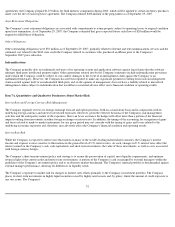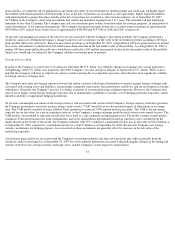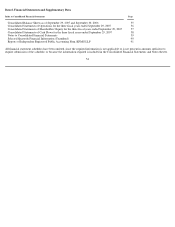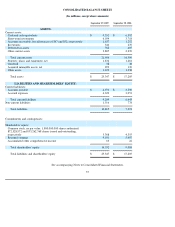Apple 2007 Annual Report Download - page 49
Download and view the complete annual report
Please find page 49 of the 2007 Apple annual report below. You can navigate through the pages in the report by either clicking on the pages listed below, or by using the keyword search tool below to find specific information within the annual report.
"Segment Information and Geographic Data" in Notes to Consolidated Financial Statements of this Form 10-K.
Americas
During 2007, net sales in the Americas segment increased $2.2 billion, or 23%, compared to 2006. The main sources of this growth were Mac
portable products, iMacs, iPods, and the sales of third-party content from the iTunes Store. Sales of Mac portable products increased due to the
popularity of the MacBook, introduced in May 2006 and updated in May 2007, as well as the MacBook Pro, introduced in January 2006 and
updated in June 2007. Sales of iMacs grew due to a shift in desktop product mix away from the Mac mini and discontinued eMac as well as the
strong reception of the new iMac introduced in August 2007. Sales of iPods grew due to increased demand for the iPod nano and iPod shuffle
and the introduction of the iPod touch in September 2007. The Company believes that the growth in iTunes Store sales was the result of
heightened consumer interest in downloading digital content and the expansion of third-party audio and video content available for sale via the
iTunes Store. During 2007, the Americas segment represented 48% of the Company's total net sales as compared to 49% in the same period of
2006. During 2007, U.S. education channel net sales and Mac unit sales increased by 14% and 18%, respectively, compared to 2006. Net sales
from the higher education market grew 17% during 2007 compared to 2006, while net sales in the K-12 market grew 10% during the same
period.
During 2006, net sales in the Americas segment increased $2.8 billion, or 41%, compared to 2005. The primary contributors to this increase were
iPods, other music related products and services, Mac portable systems, and APP. Sales of iPods increased primarily due to the introduction of
the updated iPod with video-playing capabilities in October 2005 (now referred to as iPod classic) and the iPod nano during September 2005.
The increase in other music related products and services was due to increases in sales of Apple-branded and third-party iPod accessories and
sales from the iTunes Store. The increase in sales of Mac portable systems in the Americas was due to strong sales of the MacBook and
MacBook Pro during 2006. The overall increase in net sales was partially offset by a decline in net sales of desktops, displays, and Mac OS X.
The decrease in desktop products and displays net sales reflects the overall shift in product mix toward portable Mac systems. Mac OS X sales
decreased from 2005 since the Company had not released a new version of Mac OS X since Tiger began shipping in April 2005. During 2006,
the Americas segment represented 49% of the Company's total net sales as compared to 48% in the same period of 2005.
Europe
Europe segment net sales increased $1.4 billion or 33% during 2007 compared to 2006. Consistent with the Americas segment, the primary
drivers of this growth were Mac portable products, iMacs, iPods, and the sales of third-party content from the iTunes Store. Sales of Mac
portable products increased due to the popularity of both the MacBook and MacBook Pro. Sales of iMacs grew due to a shift in desktop product
mix away from the Mac mini and discontinued eMac as well as the strong reception of the new iMac introduced in August 2007. Sales of iPods
grew primarily due to increased demand for the iPod nano and iPod shuffle. The Company believes that the growth in iTunes Store sales was the
result of heightened consumer interest in downloading digital content and the expansion of third-party audio and video content available for sale
via the iTunes Store.
Europe segment net sales increased $1.0 billion or 33% during 2006 compared to 2005. Consistent with the Americas segment, these increases
were a result of strong growth in iPod sales, other music related products and services, and Mac portable systems. Sales of iPods increased
primarily due to the introduction of the updated iPod with video-playing capabilities in October 2005 and the iPod nano during September 2005.
The increase in other music related products and services was due to increases in sales of Apple-branded and third-party iPod accessories and
sales from the iTunes Store. The increase in sales of portable systems in Europe was due to strong sales of the MacBook and MacBook Pro that
were introduced during 2006. In addition, Europe also reported increased sales in APP related to the increase in Mac unit sales. These increases
were partially offset by a decrease in desktop and Mac OS X net sales
45


